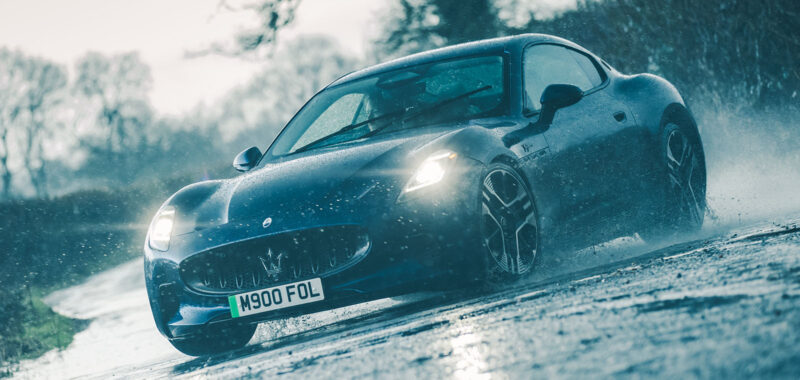With a dedicated electric motor for each of the rear wheels (they are entirely decoupled), the Granturismo Folgore needs no limited-slip differential.
The delivery of power and torque is instead determined by Maserati’s proprietary Vehicle Domain Control Module controller. How much go you get, and applied to which axle/wheel, also depends on the drive mode you’re in. Choices range from Max Range, through the default GT, into Sport and then finally Corsa. Only in Sport and Corsa are you given access to all 751bhp and 996lb ft (in GT mode, you’re limited to 80% of those figures) and it is in these modes that the chassis also hunkers down.
It almost goes without saying that the Folgore is quick enough to stunt your speech and turn your stomach. Even in damp/drying conditions at the Horiba MIRA proving ground, it gets off the line cleanly and, as with the Porsche Taycan Turbo S we tested recently, there is evidently some very considered tuning of the ESP/TC systems underpinning it all.
The Porsche’s ability to skim forward just beyond the tyres’ limit of adhesion but still with colossal forward thrust is perhaps a touch more finessed than the Maserati’s, but both cars are amazingly adept at putting power down. In sub-optimal conditions, the Folgore hit 60mph in 2.9sec, 100mph in 6.4sec and 150mph in 14.6sec.
By comparison, the V6 Granturismo Trofeo, on dry Tarmac, needed 3.6sec, 8.0sec and 18.7sec respectively. It is left for dead by its new electric sibling.
More subjectively, the Folgore is straightforward to rub along with in normal use. Even if you find yourself in Corsa mode, the initial flow of power and torque is deftly managed and never painfully sharp, with acceleration unfolding rapidly but predictably.
Moreover, while the chassis will happily get a bit of a gratifying slither on if it’s damp underwheel and you’re deliberately heavy-footed, it always seems to feel controllable, with the front axle quick – but not too quick – to straighten you out. There’s some muscle-car character here, but also plenty of polish. Again, the underlying electronics seem to be expertly calibrated.
In performance terms, braking is the only weak spot, and even then it’s a minor qualm. Stopping power is good in the context of a 2.3-tonne car, and the ability to use the paddles to vary the potentially very powerful extent of the regen effect is a genuinely involving element of the Folgore experience. There’s also rather a seamless handover between motor-elicited and proper, physical braking, but the pedal feel itself is simply too numb in general. The Taycan is more convincing here.

